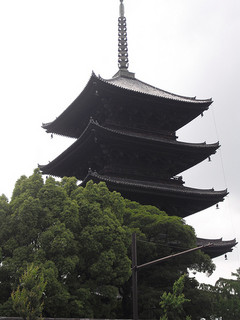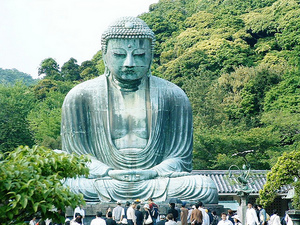National Treasures
- System Established: 1884
- Japanese: 国宝 (kokuhou)
Japan maintains several hierarchies or systems of designating objects, structures, and sites as being of cultural or historical importance. Those considered to be of the greatest importance are dubbed National Treasures. National Treasures cannot be exported, and are only loaned overseas on very rare occasions.
A select few individuals considered to be of exceptional prominence or importance in maintaining cultural traditions are named Living National Treasures.
History
The system was established in 1884, in the Meiji period, in conjunction with efforts to create a systematized set of "national" traditions, and a national narrative of Japan's history, comparable to those possessed by "modern" nation-states in the West. The first object to be designated a National Treasure was a 7th century statue of Miroku held at Kôryû-ji in Kyoto.
The Japanese government, which held Korea as a colony from 1910-1945, also compiled a list of "National Treasures of Korea." The Republic of Korea (aka South Korea) today retains that list, with numerous post-independence additions.
Up until 1932, the only buildings that could be designated National Treasures were Buddhist temples and Shinto shrines.[1] This was then modified to allow Japanese castles and other sites of historical importance to be added to the category.
Many National Treasures were sadly damaged or destroyed by Allied bombing, or otherwise, during World War II. Prior to that, there were 1,058 sites in Japan designated as National Treasures, incorporating 1,729 buildings.[2]
New legislation in 1950 divided the category of National Treasures into National Treasures and Important Cultural Properties, a prestigious but lower-ranking category.
List of National Treasures
Castles & Residences
- Hikone castle - main tenshu
- Himeji castle - various buildings
- Nijô castle - Ninomaru Palace
Paintings & Calligraphy
- Ban Dainagon Ekotoba (Idemitsu Museum, Tokyo)
- Chôjû-jinbutsu-giga (Kôzan-ji, Kyoto)
- Daitoku-ji, Kyoto:
- Mu Qi ink triptych (Kannon, crane, monkeys)
- Fusuma paintings by Kanô Eitoku and Kanô Tan'yû
- Daitoku-ji Shinju-an - various paintings, works of calligraphy, etc. including works of calligraphy by Daitô Kokushi.
- Eingakyô illustrated sutra scroll (Jôbonrendaiji, Kyoto)
- Jingo-ji, Kyoto:
- Portrait of Minamoto no Yoritomo, attr. Fujiwara no Takanobu
- Red and White Plum Blossoms folding screens, Ogata Kôrin (MOA, Museum of Art, Atami, Shizuoka pref.)
- Shaka Nyorai hanging scroll painting
- Kitano Tenjin Engi Emaki (Kitano Tenmangû, Kyoto)
- Shôkoku-ji, Kyoto:
- "Colorful Realm of Living Beings," Itô Jakuchû, set of 32 hanging scrolls
- Sôtatsu - Fûjin/Raijin screens (Kennin-ji, Kyoto)
- Tokyo National Museum:
- Sixteen Arhats set of hanging scrolls, 11th century
- Yamagoe Amida zu (painting of Amida crossing the mountains, Zenrin-ji, Kyoto)
Sculptures
- Byôdô-in (Uji, Kyoto prefecture): Amida statue by Jôchô (1053), along with other sculptures and artifacts on site
- Jôruri-ji (Kyoto): Standing Kômoku-ten, wood, 12th century
- Kôfuku-ji (Nara):
- Jûdaideshi (Ten Great Disciples) sculptures, dry lacquer, 734
- Hachibushû (Eight Legions) sculptures, including Ashura, dry lacquer, 734
- Pair of Kongô Rikishi statues
- Tentôki and Ryûtôki lantern-bearers
- Kamakura Daibutsu (Kôtô-in, Kamakura) - constructed 1252
- Kôryû-ji (Kyoto) - 7th century Miroku statue in Korean style (possibly made in Korea) - first object to be designated a National Treasure
- Tôdai-ji (Nara):
- Bonten and Taishakuten, dry lacquer, 8th c.
- Kongô Rikishi (Niô), dry lacquer, 8th c.
- Nandaimon Kongô Rikishi (Niô) - tallest free-standing wooden sculptures in Japan, by Unkei, 1203
- Shitennô, dry lacquer, 8th c.
- Tôshôdai-ji (Nara): Ganjin, dry lacquer, 8th c.
Shrines

- Itsukushima Shrine (Miyajima, Hiroshima prefecture) honden, haiden, heiden, haraedono, marôdo jinja
- Izumo Taisha (Shimane pref.) - Main Hall
- Kitano Tenmangû (Kyoto) - haiden and honden, built 1607
- Nikkô Tôshôgû (Nikkô, Tochigi prefecture) karamon
- Shimogamo Shrine (Kyoto) East and West Main Halls (honden)
- Ujigami Shrine haiden (main worship hall) - early Kamakura period, example of shinden-zukuri architecture
Swords
(See Famous Samurai Swords for a list of notable swords, including many National Treasures not listed here.)
Temples



- Byôdô-in (Uji, Kyoto): Phoenix Hall, 1053, shinden-zukuri architecture
- Daitoku-ji (Kyoto):
- Engaku-ji (Kamakura): Shariden - the oldest example in Japan of multi-storied, three-bayed, irimoya Chinese-style architecture
- Gangô-ji (Nara): Zen-dô
- Ginkaku-ji (Kyoto): Silver Pavilion (1489) and Tôgûdô (1486)
- Hannya-ji (Nara): stone pagoda (13th c.)
- Hôryû-ji (Nara):
- Bell Tower
- Chûmon gate
- East and West Corridors
- East (higashimuro) and West Dormitory (nishimuro)
- Five-story pagoda - one of the oldest wooden buildings in the world
- Kôdo (Lecture Hall)
- Kôfûzô
- Kondô - one of the oldest wooden buildings in the world
- Nandaimon gate
- Refectory (Dining Hall)
- Shôryô-in
- Sutra House (kyôzô)
- Three Sutra Hall (sankyôin)
- Tôdaimon gate
- Tôin Bell Tower
- Tôin Denpôdô
- West Octagonal Hall (saiendô)
- Yumedono
- Kiyomizu-dera (Kyoto) Main Hall
- Myôtsû-ji (Obama, Fukui prefecture) - hondô and three-story pagoda
- Kôfuku-ji (Nara):
- Three-storied pagoda
- five-storied pagoda - second tallest pagoda in Japan
- Eastern Golden Hall
- Northern Octagonal Hall
- Nanzen-ji - Large and Small hôjô
- Nishi Honganji karamon gate
- Sanjûsangendô main hall
- Tōdai-ji (Nara):
- Bell tower
- Daibutsuden - largest wooden building in the world
- Founders' Hall
- Nandaimon gate
- Nigatsu-dô
- Sangatsu-dô
- Shôsôin Imperial Treasure House
- Sutra House
- Tegaimon gate
- Tô-ji (Kyoto) pagoda - tallest wooden pagoda in Japan
Temple Bells
- Byôdô-in (Uji, Kyoto) temple bell - one of the Three Great Bells of Japan
- Engaku-ji (Kamakura) temple bell
- Kanzeon-ji (Dazaifu, Fukuoka prefecture) temple bell - one of the oldest in the country
- Kenchô-ji (Kamakura) temple bell - cast 1255
Textiles & Garments
- Several bingata garments previously owned by the Ryukyuan royal family, Naha City Museum of History
- Ryukyu investiture crown, Naha City Museum of History
Other
- Engaku-ji (Kamakura) - Buddhist relics
- Nikkô Tôshôgû:
- Black lacquered uchigatana mounting commissioned by [[Tokugawa Ieyasu[[ for a tachi blade by Sukezane.
- Tokyo National Museum:
- Gilt bronze slippers from Eta Funayama kofun, Kumamoto prefecture, 5-6th century
- Ritual objects from consecration of Kôfuku-ji, Nara, 8th century, discovered 1874
- Zenrin-ji - gilt bronze lotus-shaped gong, Tang Dynasty
Destroyed Former National Treasures
Tokyo
- Sensôji - Main Hall (hondô aka Kannon-dô) and pagoda named National Treasures in 1907; destroyed 1945.
Okinawa Prefecture
(See also National Treasures and Important Cultural Properties in Okinawa)
- Engaku-ji - named a National Treasure in 1933; destroyed in 1945. Rebuilt gates and bridge named Important Cultural Property in 1975.
- Naminoue Shrine temple bell - cast 956, named National Treasure 1907; destroyed 1945.
- Oki Shrine - named a National Treasure in 1935; destroyed 1945.
- Shuri castle - named a National Treasure c. 1925; destroyed 1945.
- Sôgen-ji - named a National Treasure in 1933; destroyed 1945.
References
- Gallery labels and explanatory plaques at various sites.
- ↑ Loo, Tze M. “Shuri Castle’s Other History: Architecture and Empire in Okinawa.” The Asia-Pacific Journal: Japan Focus 41 (12 Oct 2009).
- ↑ Suzuki Kakichi, Miyamoto Chôjirô and Ushikawa Yoshiyuki. "Ryûkyûan Architecture: Its History and Features." in Okinawa bijutsu zenshû 沖縄美術全集. vol. 5. Okinawa Times, 1989.


